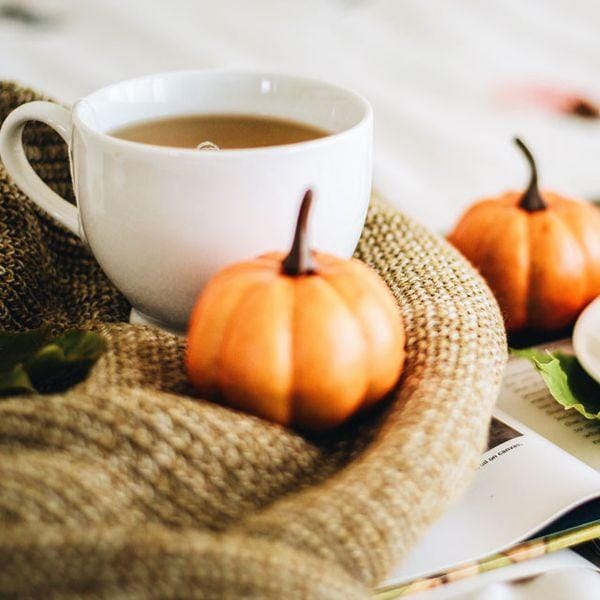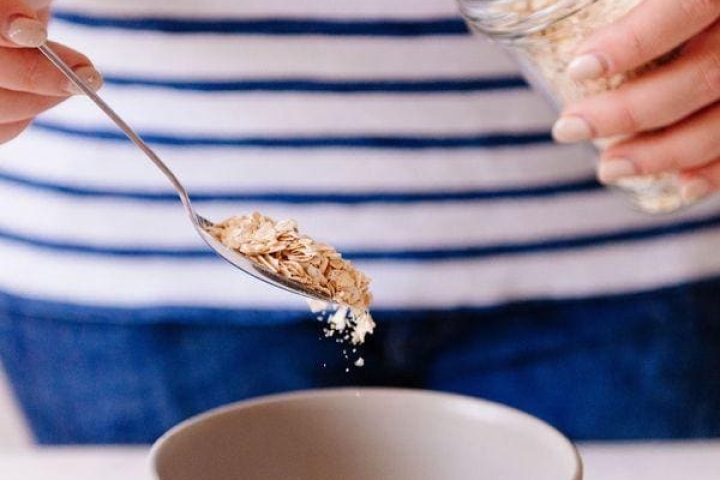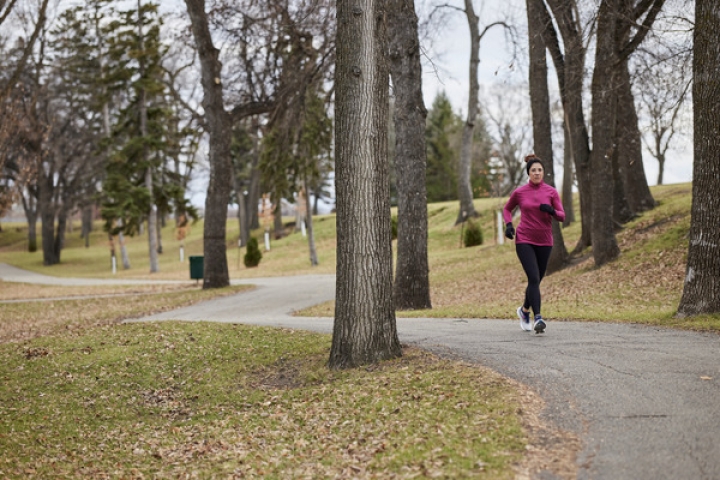What is in Pumpkin Spice? Surprisingly Good-for-You Ingredients
Did you know your favorite fall flavors may come with health benefits? Okay, maybe not that sugar-packed latte (we’ll show you how to make a healthier pumpkin spice latte in this post), but pumpkin spice ingredients do have benefits, and so do pumpkins! Plus, sweet drinks aren’t the only way to use them.
Read on to learn about the benefits of pumpkins and pumpkin spice ingredients. We’ve also included some recipe ideas to help you incorporate more of these fantastic fall flavors into your diet.
Benefits of Pumpkin & The Best Pumpkin for Recipes
Let’s start with the stars of fall—pumpkins. However, the type of pumpkin on your front porch may not be the tastiest choice for your autumn recipes. You can always pick up a can of organic pumpkin to keep it simple. But if you want to start from scratch, look for pumpkins labeled as pie pumpkins, even if you aren’t making pie.
Our favorite pumpkins for recipes include:
- Autumn Gold
- New England Pie Pumpkin
- Cinderella Pumpkin
- Neck Pumpkin
- Fairy Tale Pumpkin
- Baby Pam Pumpkin
Pumpkins are high in nutrients but low in calories, providing 245% of the daily recommended intake of vitamin A per cup.1 Moreover, a cup of pumpkin contains only about 49 calories!1 Pumpkins also boast vitamin C, potassium, copper, manganese, vitamin B2, vitamin E, iron, protein, and more.1 Many nutrients and antioxidants in pumpkins help boost immune health, which is crucial during colder months.1
But don’t overlook the seeds! Pumpkin seeds are a nutritious snack or salad topper with omega-3 and omega-6 fatty acids, along with a good amount of antioxidants and fiber.2
Now, let’s explore the benefits of those irresistible pumpkin spice ingredients.
Cinnamon Benefits
Cinnamon is one of the most beloved spices. It was used as a health tonic and even gifted to kings long before it topped our coffee and hot cocoa. The benefits are too significant to overlook.3
There are two primary types of cinnamon—Ceylon cinnamon (also known as true cinnamon) and Cassia cinnamon. Both are loaded with powerful antioxidants and cinnamaldehyde, a compound believed to be responsible for many of cinnamon’s health benefits.3,4 Ceylon cinnamon is considered superior to the cheaper Cassia variety in terms of health benefits.3,4
In addition to using cinnamon as a spice, Ceylon cinnamon supplements are a popular choice for supporting cardiovascular health. So, next time you use this spice, consider adding a little extra to your dish in the name of health!
Sprinkle true cinnamon in your coffee, tea, or hot cocoa. It's also delicious on sweet potatoes, oatmeal, apple slices, pears, and endless fall recipes like this one for Sweet Cinnamon Quinoa.
Ginger Benefits
According to experts, ginger is one of the healthiest spices on the planet.5 Derived from the ground roots of a plant in the same family as the nutritional powerhouse turmeric, ginger boasts many similar benefits.5,6
Ginger supports digestive health, blood and brain health, and may even help with menstrual discomfort and provide support for muscles and joints.5 It is water-soluble, so you can mix powdered ginger in virtually anything. Try ground ginger or fresh ginger in your smoothies, applesauce, salad dressings, and your favorite stir-fry recipes. Ginger pairs well with apricots, bananas, and blueberries. Or, experience the benefits from convenient ginger root supplements.
Nutmeg Benefits
Nutmeg is made from a seed that grows on evergreen trees native to Indonesia.7 It’s the same tree from which we derive mace (the spice, not the pepper spray). Mace spice is made from a red, lacy outer covering of the nutmeg seed and has a sweet-spicy flavor. Nutmeg adds a warming, comforting nuttiness and a hint of sweetness to dishes.
Research indicates that nutmeg promotes heart health, helps detox the liver, supports sleep, maintains pleasant breath, and aids digestive health.8 Some people also use nutmeg for hair and skin health, and nutmeg essential oil for aromatherapy.
Aside from adding this pumpkin spice ingredient to your coffee, the flavor also complements potatoes, squash, lamb, and pork. Try it in BubbForest 100% Certified Organic Ground Nutmeg.
What is Allspice?
Despite its name, allspice is not a combination of spices. It’s made from the dried berries of the Pimenta dioica tree, grown in warm climates such as Central America.9 The name allspice comes from its flavor, which hints at a variety of other spices including pepper, cloves, cinnamon, nutmeg, and juniper berries.
Beyond adding flavor to dishes across various cuisines, herbalists use allspice as a tonic for gas and related bloating, and topically as a paste to soothe muscles.10
Allspice is extremely versatile. Use it in baked goods like gingerbread or snickerdoodles. It also pairs well with dark chocolate and in rich autumn stew recipes. It’s a staple in Caribbean recipes like Jerk Chicken, and try it in these High Fiber Pumpkin Bars.
Benefits of Cloves
Cloves are the buds of flowers from the clove tree (Syzygium aromaticum) grown in Asia and South America.11 Rich in antioxidants including a compound called eugenol, studies show they may be five times more effective at fighting free radicals than vitamin E.12
The health benefits of cloves include support for healthy liver function, mineral nourishment for bones since cloves are rich in manganese, and support for stomach health concerns, immune health, and brain function.12
Cloves have a distinct flavor, and beyond your favorite pumpkin pie or gingerbread recipe, they work well in brines for pork, some curry recipes, chai tea, and mulled cider or wine. Cloves also make a delicious addition to hot herbal tea. You can press whole cloves firmly into a slice of lemon or orange and place the fruit slice in your cup, or simply sprinkle ground cloves on top.
How to Make Pumpkin Pie Spice
Satisfy your pumpkin spice craving by mixing all these delicious, healthy spices together. Try the mixture in your morning oatmeal or coffee, sprinkle some over baked squash or sweet potatoes, or use it in your favorite fall recipes like our No Bake Pumpkin Bites.
Pumpkin Spice Recipe:
-
- 2 teaspoons ground Ceylon cinnamon
- 1 teaspoon ground ginger
- 1/2 teaspoon ground cloves
- 1/4 teaspoon of ground nutmeg
This recipe makes about 15 servings at 1/4 teaspoon per serving. Make more for larger recipes and store the extra in an airtight container.
Healthier Pumpkin Spice Latte Recipe
The calories in the pumpkin spice latte recipe below will vary depending on the type of sweetener and milk you use, but if you make it with Farmer's Market Organic Canned Pumpkin, Almond Breeze Almond Milk, and BubbForest Liquid Stevia—this recipe would only have about 40 total calories!
Healthier Pumpkin Spice Latte Recipe
-
- 1/2 cup brewed coffee
- 1/2 cup of your favorite milk or nut milk (try cashew milk or almond milk)
- 1 tablespoon pumpkin puree
- 1/4 teaspoon pumpkin spice blend
- 1/8 teaspoon vanilla flavoring
- 1 tablespoon or equivalent of your favorite sweetener (try a drop of zero-calorie liquid stevia, or maple syrup)
Put all the above ingredients in a blender and blend until smooth. Do a taste test and add a touch more of any of the ingredients above to find your perfect pumpkin spice latte.
Spice Up Your Season
Pumpkin spice ingredients embody the flavor and warm comforts of fall, and with all the potential benefits they offer, you have another excuse to enjoy them.
If you like this post you may also like 5 Scary Good Taco Hacks, which includes a recipe for homemade taco seasoning, and The Sugar Scare: How to Replace Sugar with Healthier Sugar Alternatives, which offers sugar replacement options that are great to consider before the holidays.
Tell us some unique ways you use pumpkin spice ingredients in the comments below, and sign up for BubbForest Health emails to get future articles like this delivered to your inbox, along with exclusive, email-only promotions.
About Lindsey Toth, MS, RD
Registered Dietitian, BubbForest Health
Lindsey is a nationally recognized registered dietitian and nutritionist with a soft spot for ice cream. She empowers people to take charge of their health by finding the balance between the pleasure and nourishment in food.
Her philosophy is that you should take care of your body because it’s the only permanent home you have. It’s what inspired her to pursue a career in nutrition and, ultimately, led her to BubbForest Health.
Sources
1 9 Impressive Health Benefits of Pumpkin. Healthline. https://www.healthline.com/nutrition/pumpkin#section1 (Accessed 10/25/2018)
2 What are the health benefits of pumpkin seeds? Medical News Today. https://www.medicalnewstoday.com/articles/303864.php (Accessed 10/25/2018)
3 10 Evidence-Based Health Benefits of Cinnamon. Healthline. https://www.healthline.com/nutrition/10-proven-benefits-of-cinnamon#section1 (Accessed 10/25/2018)
4 Chemical composition and in vitro antioxidant and antibacterial activity of Heracleum transcaucasicum and Heracleum anisactis roots essential oil. US National Library of Medicine. https://www.ncbi.nlm.nih.gov/pmc/articles/PMC4097974/ (Accessed 10/25/2018)
5 11 Proven Health Benefits of Ginger. Healthline. https://www.healthline.com/nutrition/11-proven-benefits-of-ginger (Accessed 10/25/2018)
6 Turmeric vs. Ginger: SPICEography Showdown. Spiceography. https://www.spiceography.com/turmeric-vs-ginger/ (Accessed 10/25/2018)
7 What is Nutmeg? Where Nutmeg Comes from, How it's Used, and How to Store It. The Spruce Eats. https://www.thespruceeats.com/what-is-nutmeg-1328522 (Accessed 10/26/2018)
8 Health and nutritional benefits of nutmeg (mystica fragrans houtt.) Scientia Agriculturae. http://pscipub.com/Journals/Data/JList/Scientia%20Agriculturae/2013/Volume%201 (Accessed 10/26/2018)
9 Spices and Condiments. National Science Digital Library. https://www.researchgate.net/publication/265844733_Spices_and_Condiments (Accessed 10/26/2018)
10 The Benefits of Allspice. Verywell Health https://www.verywellhealth.com/the-benefits-of-allspice-89537 (Accessed 10/26/2018)
11 Clove tree. Encyclopedia Britannica. https://www.britannica.com/plant/clove-tree (Accessed 10/26/2018)
12 8 Surprising Health Benefits of Cloves. Healthline.https://www.healthline.com/nutrition/benefits-of-cloves#section6 (Accessed 10/26/2018)
*These statements have not been evaluated by the Food and Drug Administration. These products are not intended to diagnose, treat, cure or prevent any disease.





Leave a comment